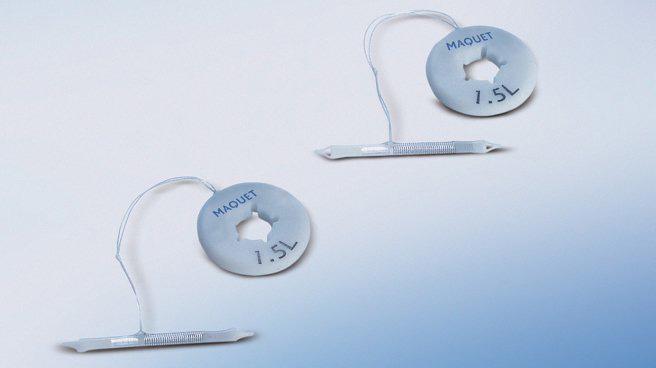
14 minute read
Facility Type is Associated with Margin Status and Overall Survival After Minimally Invasive Surgery for Pancreatic Cancer Technologies and Techniques in Coronary Revascularization ....................................................................................20
T. Clark Gamblin, MD, MS, MBA
Professor and Chief, Division of Surgical Oncology; Stuart D. Wilson Professor of Surgery; Vice Chair, Off-Campus Clinical Operations
Neha Shafique, MD
General Surgery Resident, University of Pennsylvania
Introduction
Pancreatic ductal adenocarcinoma (PDAC) is the thirdleading cause of cancer death in the United States.1 While survival can be poor, surgical resection offers the best chance of survival and remains the only potentially curative treatment modality. In recent years, there has been a trend towards increasing adoption of minimally invasive approaches, including both laparoscopic and robotic surgery, for pancreatic resections,2 with many centers reporting comparable results to open surgery.3,4
There are a number of factors that influence postoperative outcomes and survival following resection for PDAC. Prior studies have demonstrated associations between treatment at high-volume centers and improved postoperative outcomes, particularly for complex operations such as pancreatic surgery.5,6 There has also been increasing debate that surgical volume may be serving as a ‘surrogate measure’ for other factors that could have a stronger impact on this relationship, such as facility type (academic vs. community centers).7–9
There have been no studies that have assessed the relationship between facility type, facility surgical volume, and outcomes for patients undergoing PDAC resections in the setting of minimally invasive surgery. The aim of our study was to assess the effect of facility type in patients who underwent a minimally invasive pancreatectomy for PDAC and evaluate differences in postoperative outcomes and overall survival (OS). Methods
The National Cancer Database (NCDB) was utilized to retrospectively evaluate patients diagnosed with PDAC from 2010-2014. The NCDB is a nationwide prospectively collected dataset created by the Commission on Cancer (CoC) of the American College of Surgeons and the American Cancer Society that captures 70% of all new cancer diagnoses within the United States.12 Patient demographics and clinical characteristics captured include age, sex, race, and Charlson-Deyo Combined Comorbidity Score (CDCC).13 Clinical stage and tumor grade was designated based on the American Joint Commission on Cancer (AJCC) 7th edition. Pancreatectomy included Whipple pancreaticoduodenectomy, distal pancreatectomy, and total pancreatectomy The definition of CoC facility types is based on cancer program structure, services provided, and number of cancer cases accessioned per year. Facility pancreatectomy volume was calculated using de-identified facility identification codes assigned by the NCDB. Results A total of 2,136 patients were diagnosed with PDAC between 2010 and 2014 who met the inclusion criteria. Of those patients, 542 (25.4%) were treated at community centers and 1,594 (74.6%) were treated at academic centers. De-
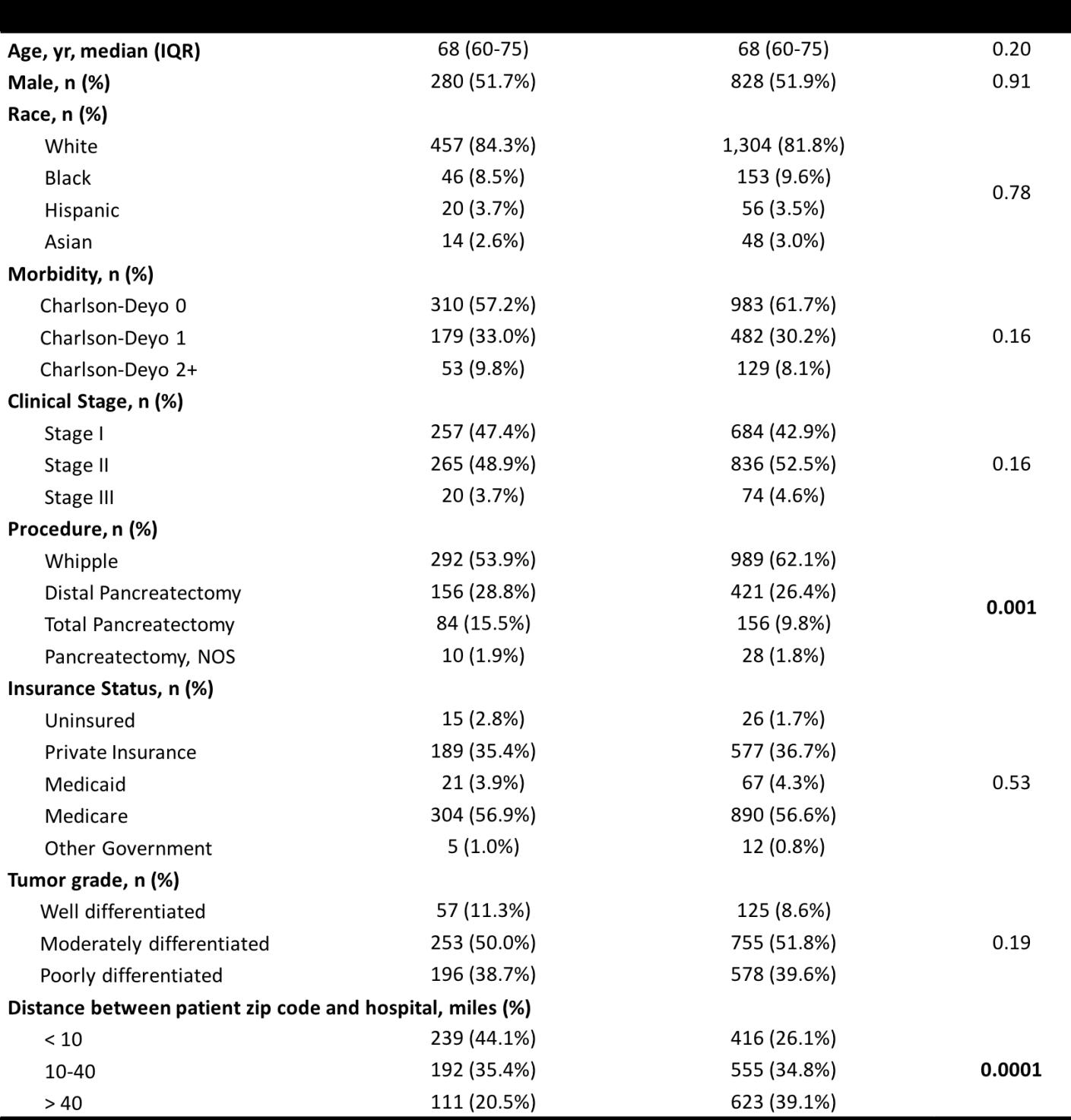
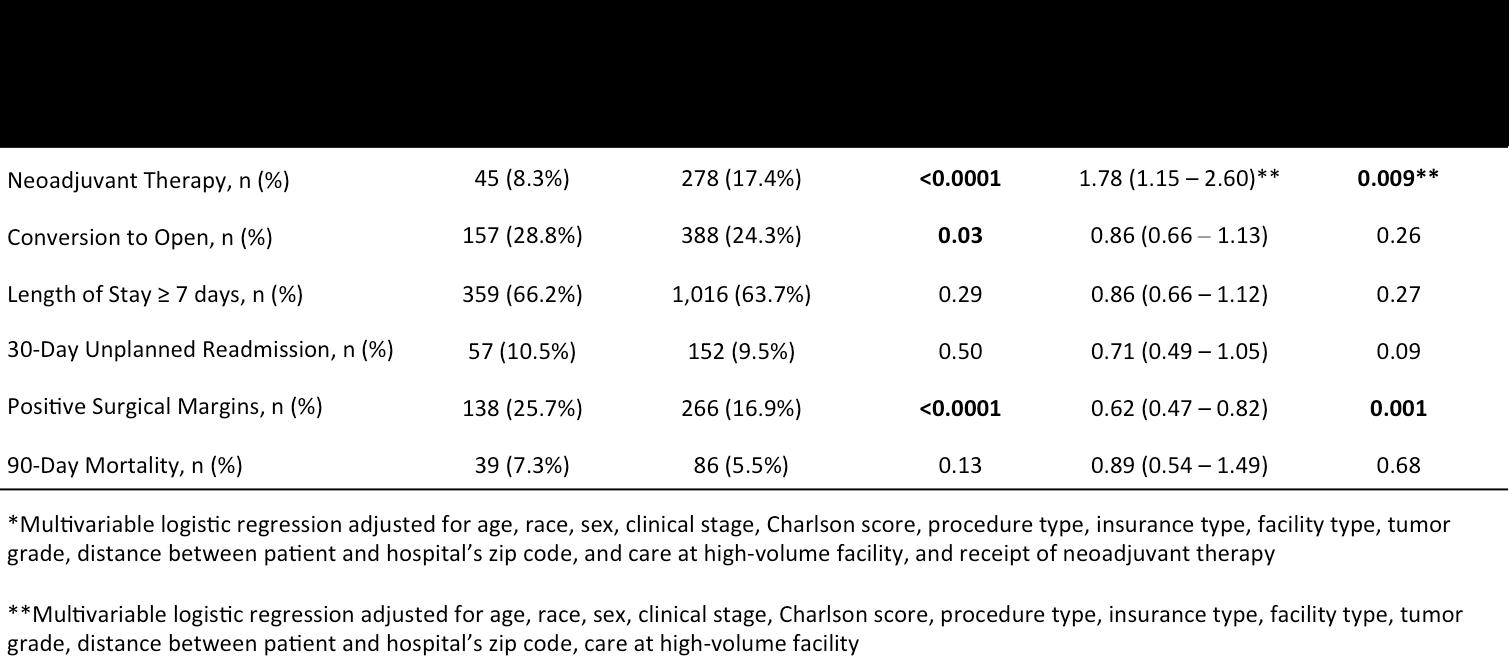
Table 2: Odds of clinical and oncologic outcomes for patients undergoing minimally invasive pancreatic resection at academic vs community centers.
mographic variables were comparable between the two groups (Table 1). There were no significant differences in age, sex, race, comorbidity as measured by the CharlsonDeyo score, clinical stage, tumor grade, or insurance status (all p > 0.05). However, patients treated at academic hospitals were more likely to undergo a Whipple pancreaticoduodenectomy (62.1% vs 53.9%, p < 0.0001).
Univariate analysis demonstrated differences in clinical and oncologic outcomes associated with facility type (Table 2). Patients who underwent resection at academic centers were more likely to receive neoadjuvant therapy (17.4% vs 8.3%; p < 0.0001), were less likely to have their minimally invasive surgery converted to an open approach (24.3% vs 28.8%; p = 0.03), and had fewer positive surgical margins (16.9% vs 25.7%; p < 0.0001).
In the multivariate analysis that included patient and disease characteristics along with care at a high volume facility, surgery at an academic center continued to be significantly associated with higher rates of receiving neoadjuvant therapy (OR, 1.78; 95% CI, 1.15 – 2.60; p = 0.009). After including receipt of neoadjuvant therapy to the multivariate analysis, patients at academic centers were still significantly less likely to have positive surgical margins (OR, 0.62; 95% CI 0.47 – 0.82; p = 0.001).
Kaplan-Meier curves demonstrated longer OS for patients who underwent resection at academic centers (p = 0.0003, Figure 1). Patients who underwent treatment at an academic center had a median OS of 23.7 months compared with 19.1 months for patients who underwent treatment at a community center (p < 0.05).
On multivariate analysis, treatment at an academic center continued to be associated with improved OS (HR 0.84, CI 0.73-0.97, p=0.02, Table 3). Importantly, this association remained significant even after adjusting for receipt of neoadjuvant therapy and surgical margin status, which had been found to be independently associated with treatment at an academic center.
Discussion
This analysis of 2,136 patients who underwent minimally-invasive pancreatic resection for PDAC showed that treatment at an academic center was associated with higher rates of receiving neoadjuvant therapy, fewer positive resection margins, and longer OS than treatment at a community center, even after adjusting for patient factors, disease characteristics, and facility surgical volume. These data suggest that facility type, independent of, and, in addition to facility surgical volume, can be an important driver of postoperative outcomes and long-term survival for patients. Our study adds to a growing body of evidence that academic facility type can be independently associated with improved outcomes.7,10,11
Interestingly, there were no differences between academic and community centers in terms of surgical outcomes, including prolonged length of stay, unplanned readmissions, or short-term mortality, which were comparable between the two cohorts. In addition, rates of conversion to an open approach were similar in both groups, Instead, differences were exhibited in oncologic outcomes such as receipt of neoadjuvant therapy, surgical margin status, and long-term survival. There are many reasons care at an academic center may be associated with improved onco-

Article continued from page 17
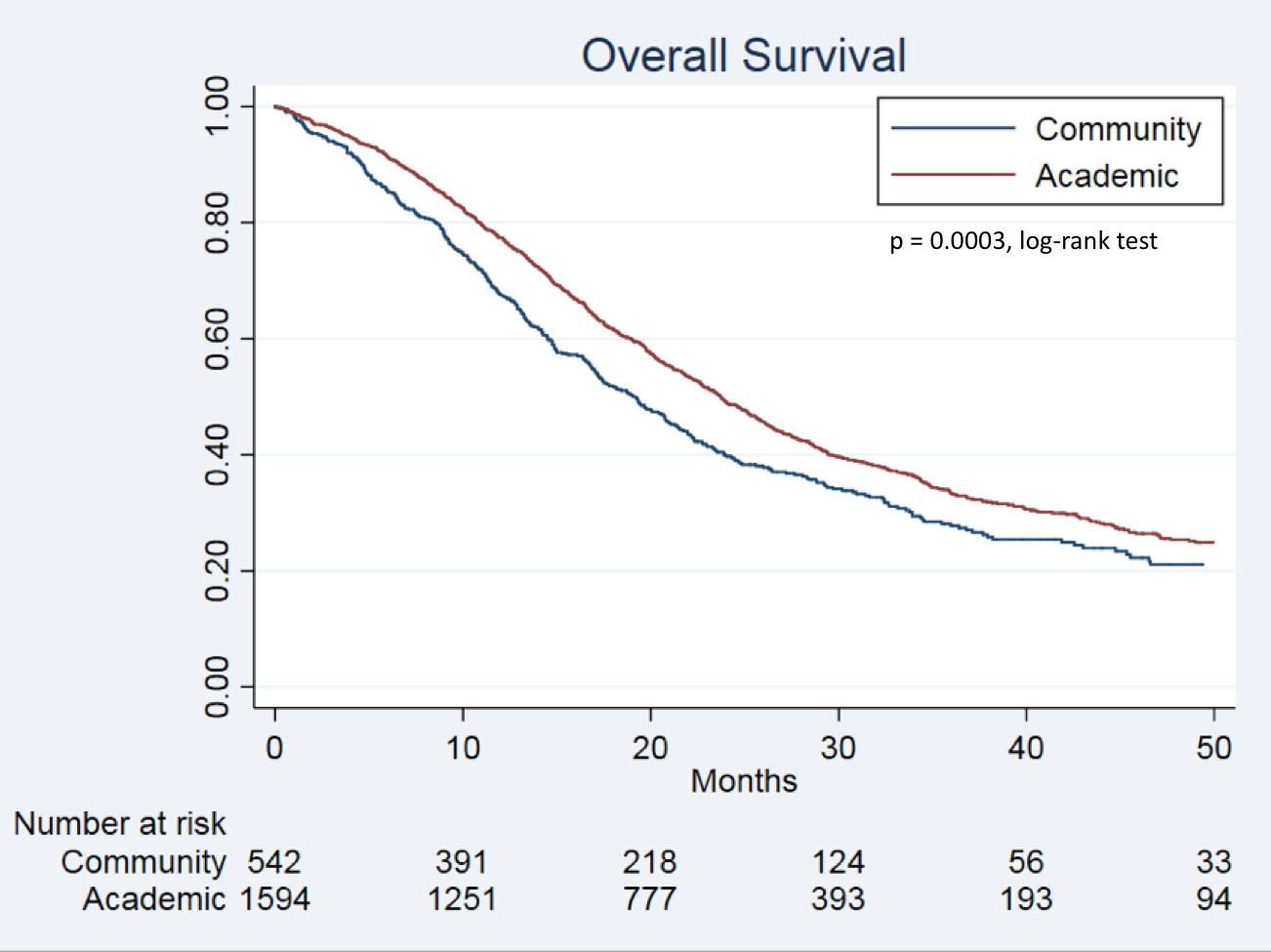
Figure 1: Kaplan – Meier curves depicting overall survival for patients undergoing minimally invasive pancreatic resections based on facility type.
logic outcomes. Pancreatic cancer, in particular, requires carefully coordinated multidisciplinary care in order to optimize necessary multimodal treatment.14 Increased surgeon and pathologist experience and specialization at academic centers could enhance rates of negative-margin resections. While both neoadjuvant therapy and complete tumor excision have been recognized in their contribution to long-term survival, particularly in more advanced localized tumors,15 academic centers were also independently associated with OS. This may reflect improved access to novel clinical trials, standardized and aggressive methods of patient follow-up and surveillance, and greater experience among multidisciplinary teams in academic centers.
The limitations of this study include the retrospective nature of the analysis resulting in unmeasured confounders. The NCDB does not collect data on postoperative complications and disease recurrence so we are unable to assess the effect of facility type on these important outcomes and measures such as disease-free and diseasespecific survival. Furthermore, as all hospitals that contribute to NCDB are members of the CoC. Thus, findings may not be generalizable to non-CoC facilities. Conclusion
Treatment at an academic center is associated with higher rates of receiving neoadjuvant therapy and fewer positive surgical margins for patients undergoing minimally invasive resections for PDAC. After adjusting for patient and facility characteristics, receipt of neoadjuvant therapy, positive surgical margins, and treatment at an academic center continued to be independently associated with longer OS.
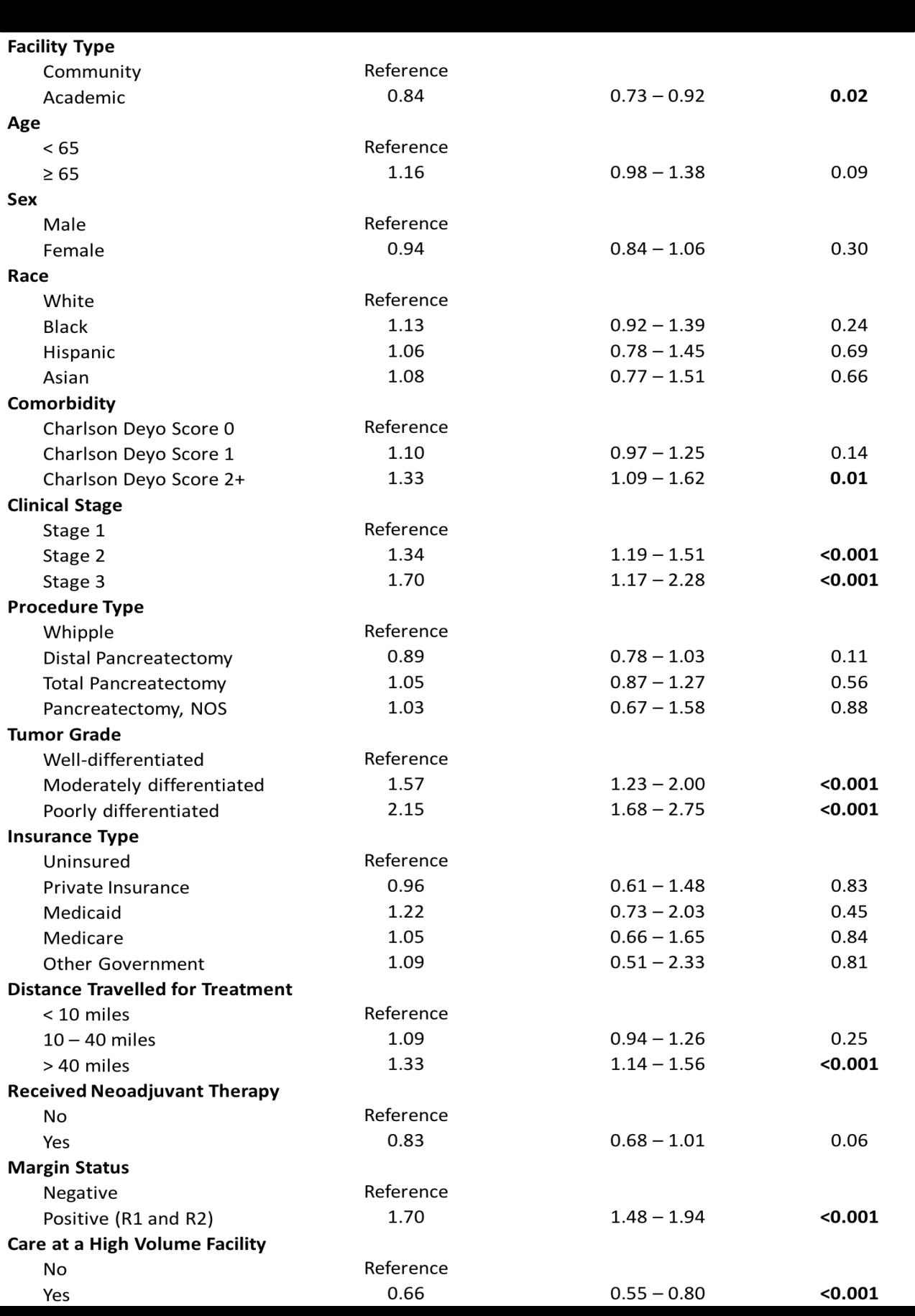
Table 3: Multivariate adjusted Cox regression of predictors of mortality for patients undergoing minimally invasive pancreatic resections.
FOR ADDITIONAL INFORMATION on this topic, visit www.mcw.edu/surgery or contact Dr. T. Clark Gamblin at tcgamblin@mcw.edu.
REFERENCES 1. American Cancer Society. Cancer Facts and Figures.; 2019. https://www.cancer.org/content/dam/cancerorg/research/cancer-facts-and-statistics/annualcancer-facts-and-figures/2019/cancer-facts-andfigures-2019.pdf. Accessed July 15, 2019. 2. Okunrintemi V, Gani F, Pawlik TM. National Trends in Postoperative Outcomes and Cost Comparing
Minimally Invasive Versus Open Liver and Pancreatic
Surgery. J Gastrointest Surg. 2016;20(11):1836-1843. doi:10.1007/s11605-016-3267-z. 3. Zureikat AH, Beane JD, Zenati MS, et al. 500 Minimally
Invasive Robotic Pancreatoduodenectomies.
Ann Surg. December 2019:1. doi:10.1097/
SLA.0000000000003550.
4. Kim HS, Kim H, Kwon W, et al. Perioperative and oncologic outcome of robot-assisted minimally invasive (hybrid laparoscopic and robotic) pancreatoduodenectomy: based on pancreatic fistula risk score and cancer/staging matched comparison with open pancreatoduodenectomy. Surg Endosc.
April 2020. doi:10.1007/s00464-020-07551-2. 5. Luft HS, Bunker JP, Enthoven AC. Should Operations
Be Regionalized?: The Empirical Relation between Surgical Volume and Mortality. N Engl
J Med. 1979;301(25):1364-1369. doi:10.1056/
NEJM197912203012503. 6. Finks JF, Osborne NH, Birkmeyer JD. Trends in hospital volume and operative mortality for high-risk surgery.
N Engl J Med. 2011;364(22):2128-2137. doi:10.1056/
NEJMsa1010705. 7. Hyder O, Sachs T, Ejaz A, Spolverato G, Pawlik TM.
Impact of Hospital Teaching Status on Length of
Stay and Mortality Among Patients Undergoing
Complex Hepatopancreaticobiliary Surgery in the
USA. J Gastrointest Surg. 2013;17(12):2114-2122. doi:10.1007/s11605-013-2349-4. 8. Finlayson SRG. The volume-outcome debate revisited. Am Surg. 2006;72(11):1038-42; discussion 1061-9, 1133-1148. http://www.ncbi.nlm.nih.gov/ pubmed/17120945. Accessed April 14, 2020. 9. Khuri SF, Henderson WG. The case against volume as a measure of quality of surgical care. World J Surg. 2005;29(10):1222-1229. doi:10.1007/s00268-0057987-6. 10.Chapman BC, Paniccia A, Hosokawa PW, et al. Impact of Facility Type and Surgical Volume on 10-Year
Survival in Patients Undergoing Hepatic Resection for
Hepatocellular Carcinoma. In: Journal of the American
College of Surgeons. Vol 224. Elsevier Inc.; 2017:362372. doi:10.1016/j.jamcollsurg.2016.11.011. 11.Chu QD, Zhou M, Peddi P, et al. Influence of facility type on survival outcomes after pancreatectomy for pancreatic adenocarcinoma. HPB. 2017;19(12):10461057. doi:10.1016/j.hpb.2017.04.017. 12.National Cancer Database. American College of
Surgeons. 13.Hackert T, Sachsenmaier M, Hinz U, et al. Locally advanced pancreatic cancer: Neoadjuvant therapy with folfirinox results in resectability in 60% of the patients. Ann Surg. 2016;264(3):457-461. doi:10.1097/SLA.0000000000001850. 14.Report SS-UN and W, 2015 undefined. Hospitals move to limit low-volume surgeries. 15.Fong ZV, Loehrer AP, Fernández-del Castillo C, et al. Potential impact of a volume pledge on spatial access: A population-level analysis of patients undergoing pancreatectomy. Surg (United
States). 2017;162(2):203-210. doi:10.1016/j. surg.2017.03.010. REFERENCES FROM PAGE 11 Social Adversity is Part of the Disease: Healthcare Disparities Among Patients with Pancreatic Cancer 1. Moffitt RA, Marayati R, Flate EL, et al. Virtual microdissection identifies distinct tumor- and stroma-specific subtypes of pancreatic ductal adenocarcinoma. Nat Genet. 2015;47(10):11681178. doi:10.1038/ng.3398 2. Von Hoff DD, Ervin T, Arena FP, et al. Increased
Survival in Pancreatic Cancer with nab-Paclitaxel plus Gemcitabine. N Engl J Med. 2013;369(18):16911703. doi:10.1056/nejmoa1304369 3. Krepline A, Tsai S. Has Personalized Medicine for
Pancreatic Cancer Arrived? Adv Surg. 2019;53:103115. doi:10.1016/j.yasu.2019.04.006 4. Evans DB, Kamgar M, Tsai S. Goals of Treatment
Sequencing for Localized Pancreatic Cancer. Ann
Surg Oncol. 2019;26(12):3815-3819. doi:10.1245/ s10434-019-07738-5 5. Feinstein JS. The Relationship between
Socioeconomic Status and Health: A Review of the Literature. Milbank Q. 1993;71(2):279. doi:10.2307/3350401 6. Mokdad AH, Dwyer-Lindgren L, Fitzmaurice C, et al. Trends and patterns of disparities in cancer mortality among US Counties, 1980-2014. JAMA - J
Am Med Assoc. 2017;317(4):388-406. doi:10.1001/ jama.2016.20324 7. Shapiro M, Chen Q, Huang Q, et al. Associations of socioeconomic variables with resection, stage, and survival in patients with early-stage pancreatic cancer. JAMA Surg. 2016;151(4):338-345. doi:10.1001/jamasurg.2015.4239 8. Noel M, Fiscella K. Disparities in Pancreatic
Cancer Treatment and Outcomes. Heal Equity. 2019;3(1):532-540. doi:10.1089/heq.2019.0057 9. Patel KG, Borno HT, Seligman HK. Food insecurity screening: A missing piece in cancer management.
Cancer. 2019;125(20):3494-3501. doi:10.1002/ cncr.32291 10.Gany F, Lee T, Ramirez J, et al. Do our patients have enough to eat? Food insecurity among urban low-income cancer patients. J Health Care Poor
Underserved. 2014;25(3):1153-1168. doi:10.1353/ hpu.2014.0145 11.Mora J, Krepline AN, Aldakkak M, et al. Adjuvant therapy rates and overall survival in patients with localized pancreatic cancer from high
Area Deprivation Index neighborhoods. Am
J Surg. Published online 2020. doi:10.1016/j. amjsurg.2020.12.001

David L. Joyce, MD, MBA
Associate Professor, Division of Cardiothoracic Surgery
Disclosures: The Impella-Supported Off-Pump Coronary Artery Bypass Grafting In High-Risk Revascularizations: A Single-Center Prospective Observational Study has been funded through Abiomed (Danvers, MA) as part of an investigator initiated study. Dr. David Joyce serves as a paid consultant and adjudicator on the Clinical Event Committee (CEC) for Abiomed studies.
Coronary artery bypass grafting (CABG) is perhaps the most studied procedure in the history of surgery. And yet despite an astonishing number of well conducted large multi-center prospective randomized trials, there is very little agreement on which technical strategies related to this procedure will yield the optimal outcomes. An incomplete list of topics on which surgeons strenuously disagree includes: • What type of incision should we make (limited thoracotomy or median sternotomy)? • Which side of the table should the surgeon stand on to achieve optimal exposure of the distal targets? Is it better to use a “Heart Net” or a human hand to position the heart? • Should we use the heart lung machine or not? • Is it better to fashion the distal anastomoses with interrupted or continuous sutures? • In off pump surgery, is it better to ligate the vessel with a silastic band or place an intracoronary shunt? • How many arterial conduits should we use? Which ones? Assuming we all see value in a left internal mammary, should it be taken down as a pedicle or skeletonized? • If you’re using a vein, should the conduit be harvested endoscopically, open, or “skip” incisions? • Is it OK to put a side-biting clamp on the aorta to perform the proximal anastomoses, or does this protect the myocardium at the expense of increasing the stroke risk? • What is the best strategy for delivering cardioplegia? Antegrade? Retrograde? Both at the same time?
Down the grafts? Should it be warm, cold, or tepid?
Buckberg or Delnido? • Which sternal closure technique leads to the lowest rate of nonunion? Figure of eight? Simple interrupted? Cables? Plates? (Rumor has it even cardiac surgeons in the same family can’t seem to agree on this one…)
It is incredible that there are so many things that we disagree on when you consider that we have literally been performing this operation since Favaloro introduced it to the world in 1967.1 Actually, technically speaking it was Robert Goetz and Albert Einstein who did the first one in 1960. Come to think of it, shouldn’t Vladimir Demikhov be the one that gets credit for his experimental work in 1953?2 But I digress… Nowhere do these Figure 1: The Abiomed Impella technical nuances play 5.5 is inserted through a surgical a greater role than in graft sewn to the right axillary artery and delivered over a wire across the aortic valve. the management of patients with severely depressed ejection fraction (defined in the STICH trial as EF<35%).3 Based on the old adage that EF and mortality shake hands at around 15%, it seems reasonable that how we perform CABG in these patients may significantly influence the surgical outcomes that matter the most. While mortality after high risk CABG can be attributed to a variety of factors, the vast majority of deaths originate in the development of Low Output State (LOS).4 In a typical scenario, CABG is performed by arresting the heart by placing a cross clamp on the aorta and administering cardioplegia down the coronary arteries. For a normal ventricle, the myocardial injury induced by this maneuver is well tolerated, but in patients with severely depressed EF there may not be enough functioning myocytes left to provide adequate end-organ perfusion after surgery. The innovative strategy put forward in the trial aims to both mitigate the extent of myocardial injury and support the circulation in the perioperative period to preserve end-organ function. This is done by implanting an Impella 5.5 short term mechanical circulatory support device at the time of coronary revascularization, which is performed on a beating heart with the use of intra-coronary shunts to achieve optimal myocardial protection. The Impella 5.5 is left in place for as long as needed after surgery to maintain adequate cardiac indices during the early recovery phase when risk for LOS is highest.
This feasibility study represents an important milestone for the Department of Surgery and the Medical College of Wisconsin as one of the first successful Investigational Device Exemption (IDE) applications submitted to the Food and Drug Administration (FDA). The primary objectives of the study include demonstrating a reduction in myocardial injury through preservation of coronary blood flow as
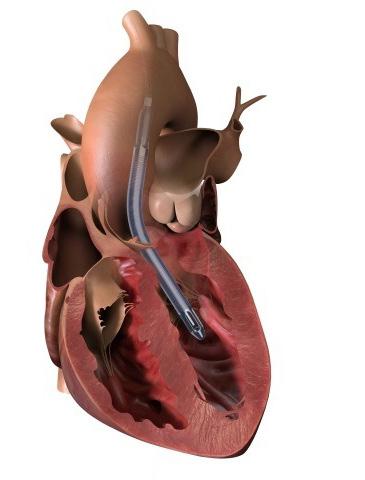
Figure 2. A silastic coronary shunt is used during beating heart revascularization to optimize myocardial protection.5
well as establishing peri-operative hemodynamic stability to eliminate the risk of LOS. It is hoped that the achievement of these objectives will lead to a Premarket approval (PMA) for the use of Impella 5.5 as a new strategy for high risk coronary revascularization.
FOR ADDITIONAL INFORMATION on this topic, visit www.mcw.edu/surgery or contact Dr. David Joyce at djoyce@mcw.edu.
REFERENCES 1. Mueller RL, Rosengart TK, Isom OW. The history of surgery for ischemic heart disease. Ann Thorac
Surg 1997;63(3):869-78 doi: 10.1016/s00034975(96)01375-6[published Online First: Epub
Date]|. 2. Konstantinov IE. The first coronary artery bypass operation and forgotten pioneers. Ann Thorac
Surg 1997;64(5):1522-3 doi: 10.1016/S00034975(97)00928-4[published Online First: Epub
Date]|. 3. Velazquez EJ, Lee KL, Deja MA, et al. Coronaryartery bypass surgery in patients with left ventricular dysfunction. N Engl J Med 2011;364(17):1607-16 doi: 10.1056/NEJMoa1100356[published Online First:
Epub Date]|. 4. Joyce DL. High-risk cardiac surgery, transplant, or mechanical support? The answer can be “all of the above”. J Thorac Cardiovasc Surg 2018;155(1):234-35 doi: 10.1016/j.jtcvs.2017.08.033[published Online
First: Epub Date]|. 5. Joyce, D., & Joyce, L.(2019-12).Mechanical Circulatory
Support: Principles and Applications. Oxford,
UK: Oxford University Press. Retrieved 13
Apr. 2021, from https://oxfordmedicine.com/ view/10.1093/med/9780190909291.001.0001/med9780190909291.
